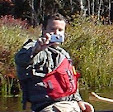 |
| Hole at the bottom of the Millville Rapid |
The original plan was to run the section from River Bend Farm to the Gorge, but we scouted the Millville Rapid and found a large hole at the bottom due to high water. It was smiling at us (a good sign), but with only two of us we still decided to take a pass and run the section from Plummers Landing down to Route 16.
 |
| Heading down form Plummers Landing |
About a mile downstream, the river breached the old Blackstone Canal on the right, and much of the water now flows down the old canal trench. The canal is blocked with trees, so you need to stay left to remain in the river. From there, the river twists and turns, and it is a challenge to maneuver around the s-turns and through the strainers.
 |
| Goat Hill Lock |
We stayed right on Rice City Pond and paddled down the flooded-out section of the old Blackstone Canal to the stone-arch bridge at Hartford Avenue. From there, we crossed over to the river to continue our run down to Route 16.
 |
| Running the broken dam at Route 16 |
Rather than portaging over to the canal, we continued downstream to run the broken dam at Route 16. In spite of a large strainer in the middle, there was an easy line to the left. We ran the drop and did a little surfing before calling it a day.
Links:









